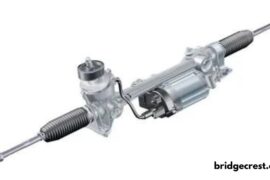Ever wonder how your car smoothly navigates turns and bends? A key player in this seamless experience is the steering rack. This often overlooked component is crucial for vehicle control and safety. Let’s dive into what a steering rack is, how it works, and why it’s vital for your car’s performance.
What is a Steering Rack?
The steering rack is a crucial part of the steering system, converting the rotational motion of the steering wheel into linear motion to turn the wheels. It plays a pivotal role in ensuring that your vehicle responds accurately to your inputs, making driving not only smoother but also safer.
Basic Functionality
At its core, a steering works through a simple but effective mechanism. When you turn the steering wheel, it rotates a pinion gear, which then moves the rack—a bar with teeth on one side—left or right. This movement controls the direction of the front wheels, guiding the vehicle as you steer. A typical rack system consists of the rack, the pinion gear, tie rods, and the power steering pump (in power-assisted systems). Each component plays a specific role in translating the driver’s input into wheel movement.
Types of Steering Racks
- Manual Steering Racks: Manual racks are straightforward, using only the driver’s physical effort to steer. They are simple and reliable but require more force to turn the wheel, especially at lower speeds.
- Power Steering Racks: Power steering, equipped with hydraulic assistance, reduce the effort needed to turn the wheel. This system uses a pump to circulate fluid and assist in steering, making it easier to maneuver the vehicle.
- Electric Power Steering (EPS) Racks: The latest in steering technology, EPS racks use electric motors to assist steering. They offer precise control, improved fuel efficiency, and adaptive features, making them popular in modern vehicles.
How Does a Steering Rack Work?
The steering rack operates through the rack and pinion mechanism. This system is praised for its efficiency and direct response, making it a standard choice in many vehicles today. In this setup, the pinion gear rotates with the steering wheel, engaging with the teeth on the rack. This interaction translates the rotational movement into the linear motion needed to steer the wheels.
Exploring Custom Steering Solutions
For those looking to enhance their driving experience beyond standard options, custom steering solutions offer a unique avenue. Whether it’s upgrading to a high-performance for better precision on the track or opting for a bespoke setup tailored to specific driving preferences, the possibilities are vast. Custom solutions can significantly improve steering feel and response, giving drivers a more connected and satisfying experience behind the wheel. However, it’s essential to work with experienced professionals to ensure these modifications are compatible with your vehicle and driving style.
Advantages of Modern Steering Racks
Modern steering come with several advantages that enhance the driving experience. With advancements in technology,racks now offer unparalleled precision. This means drivers can enjoy better handling, especially in complex driving conditions. Features like variable assist, which adjusts the level of assistance based on speed, enhance safety by providing the right amount of control for different driving situations.
Common Issues with Steering Racks
Common signs include unusual noises when steering, difficulty turning the wheel, and fluid leaks. These symptoms indicate potential problems that need immediate attention. Wear and tear, fluid contamination, and physical damage are typical causes. Regular maintenance can help prevent these issues, ensuring your steering remains in good condition. Maintaining your steering rack is crucial for prolonging its lifespan and ensuring your vehicle’s safety.
Fluid Checks and Replacements
For power steering systems, keeping the fluid at the right level and replacing it periodically is essential. Clean fluid helps the system operate smoothly and prevents damage to components. At times, replacing the steering rack might be necessary to maintain vehicle safety and performance. If your steering feels loose or unresponsive, or if you notice leaks or grinding noises, it may be time to replace the steering rack. Ignoring these signs can lead to more severe problems.
DIY vs. Professional Replacement
While some may attempt to replace a steering rack themselves, it’s generally recommended to seek professional help. The process requires specialized tools and knowledge to ensure the new rack is installed correctly. Understanding the costs involved in replacing or maintaining a steering rack can help you budget effectively. The make and model of your vehicle,and labor costs all influence the total expense. It’s wise to get multiple quotes and consider both quality and cost.
Upgrading Your Steering Rack
- Benefits of Upgrading: Newer steering often come with enhanced features like improved responsiveness and better fuel efficiency. They can significantly improve your driving experience.
- Choosing the Right Upgrade for Your Vehicle: When upgrading, consider compatibility, desired features, and budget. Consulting with a professional can help you make an informed decision.
- Environmental Impact of Steering Racks: Steering, like many automotive components, have environmental considerations.
- Eco-Friendly Options: Choosing recycled or remanufactured steering can reduce waste and conserve resources. Additionally, electric power steering systems are more energy-efficient and environmentally friendly.
The Future of Steering Rack Technology
Advancements in EPS systems continue to improve efficiency and driver control. Future developments may include more integration with autonomous driving systems.
As self-driving technology progresses, steering systems will need to adapt. This could mean more sophisticated electronic controls and enhanced safety features.
FAQs About Steering Racks
What causes a steering rack to fail?
Common causes include wear and tear, fluid leaks, and physical damage from impacts.
How long does a steering rack last?
With proper maintenance, a steering can last anywhere from 100,000 to 150,000 miles or more.
Can a steering rack be repaired?
In some cases, yes. However, depending on the extent of the damage, replacement may be more cost-effective.
Is it safe to drive with a bad steering rack?
It’s not recommended. A failing steering can impair vehicle control, posing a significant safety risk.
What are the signs of a bad steering rack?
Symptoms include difficulty steering, unusual noises, and visible fluid leaks.
Conclusion
The steering rack is an essential component of your vehicle, influencing everything from handling to safety. Regular maintenance, timely repairs, and being aware of the latest advancements can ensure a smooth and safe driving experience. Whether you’re a DIY enthusiast or prefer professional help, understanding the ins and outs of your steering system is crucial for keeping your car in top shape.











